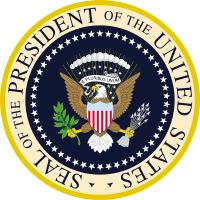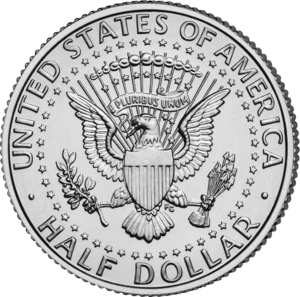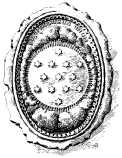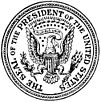Seal of the president of the United States facts for kids
Quick facts for kids Seal of the presidentof the United States |
|
|---|---|
 |
|
| Armiger | President of the United States |
| Adopted | Unknown (current definition from 1945) |
| Crest | Behind and above the eagle a radiating glory Or, on which appears an arc of thirteen cloud puffs proper, and a constellation of thirteen mullets argent |
| Blazon | Paleways of thirteen pieces argent and gules, a chief azure |
| Supporters | An American eagle displayed holding in its dexter talon an olive branch and in its sinister a bundle of thirteen arrows all proper, and in its beak a white scroll inscribed E PLURIBUS UNUM sable |
| Motto | E pluribus unum |
| Other elements | The whole surrounded by white stars arranged in the form of an annulet with one point of each star outward on the imaginary radiating center lines, the number of stars conforming to the number of stars in the union of the Flag of the United States |
| Use | On documents from the U.S. president to the U.S. Congress, and as a symbol on presidential vehicles, podiums, and other places |
The seal of the president of the United States is a special symbol. It is used on letters from the president of the United States to the U.S. Congress. It also acts as a symbol for the presidency itself.
The main design on the seal comes from the Great Seal of the United States. This design is the official coat of arms for the U.S. presidency. You can also see it on the presidential flag.
The presidential seal changed over many years before it became official law. We don't know much about its very early history. Presidents have used seals since at least 1850, and probably even earlier. The basic look of today's seal started with Rutherford B. Hayes. He was the first to use the coat of arms on White House invitations in 1877. The exact design we see today was set in 1945 by President Truman. The only changes since then were in 1959 and 1960. These changes added the 49th and 50th stars to the circle when Alaska and Hawaii became states.
Contents
Understanding the Seal's Design
The current seal's design was set by President Dwight D. Eisenhower. This happened on February 5, 1960, and it became official on July 4, 1960.
The design is mostly the same as the front of the Great Seal of the United States. That design was first made in 1782. The presidential seal has some extra colors and a different way the stars and clouds are placed. The unique part is the circle of 50 stars. These stars stand for the 50 states in the country.
The symbols on the seal mean the same things as on the Great Seal:
- The stripes on the shield show the 13 original states. They are united and support the country.
- The motto, E Pluribus Unum, means "Out of many, one." This also refers to the original states coming together.
- The arc of thirteen clouds and the thirteen stars also represent the original 13 states.
- The olive branch and arrows show the president's powers of peace and war.
How the Seal is Used
Official Presidential Use
The actual metal stamp (called a "die") of the seal is only used on letters from the president to the U.S. Congress. These letters are sealed with wax. This has been the main use of the seal for a long time. Documents signed by the president when representing the nation use the Great Seal of the United States instead.
The brass die at the White House is the only "actual" seal. Other versions are copies. The Bureau of Engraving and Printing makes other copies for documents, stationery, and invitations. These copies are often used as a visual symbol for the president. You can often see them:
- On the podium at presidential press conferences and rallies.
- On the sides of presidential vehicles like Air Force One, Marine One, and the presidential limousine.
- In the middle of the ceiling in the Oval Office at the White House.
- On the balcony of the South Portico during special welcome ceremonies for leaders from other countries.
The presidential coat of arms is the main design on the seal. It does not include the words "SEAL OF THE PRESIDENT OF THE UNITED STATES" around it. This coat of arms is used even more widely. You can find it:
- On the presidential flag.

- On the back of the Kennedy half dollar coin.
- In the center of the famous oval rug in the Oval Office of the White House. Most presidents since Truman have used this design on their rugs.
- On the Presidential Service Badge given to U.S. Military personnel.
- On many sets of presidential china, used for state dinners at the White House.
- At the burial sites of former presidents.
Rules for Using the Seal
Generally, businesses are not allowed to use the seal. This rule is set by U.S. law. The United States Secret Service is allowed to use the seal for fundraising for its charity.
The White House Graphics and Calligraphy Office watches over unofficial uses of the seal. They make sure people use it correctly. For example, in 2005, a White House lawyer asked The Onion, a satirical newspaper, to remove the seal from its website. The office can approve the seal's use for official gifts. An example is when it was put on a silver cigarette box given to Franklin Roosevelt.
History of the Presidential Seal
We don't know much about the very first presidential seals. It seems they were mainly used to seal envelopes sent to Congress. These envelopes were often thrown away, so there aren't many records left. The first seal we know about was in 1850. The design used today started with a coat of arms on invitations from President Hayes in 1877. It wasn't officially defined by law until President Truman issued an executive order in 1945.
Seal of the Congress President
Before the U.S. federal government began, there was a president of the Continental Congress. This person had a seal. It was a small oval with a design from the Great Seal. It had thirteen stars surrounded by clouds and the motto E Pluribus Unum. This seal was also used to seal envelopes sent to Congress. Its use did not continue when the new government started in 1789.
Early Presidential Seals
We have little proof of seals used by early U.S. presidents. The first clear record is from 1850. President Fillmore submitted a rough drawing for a seal. It showed an eagle with its wings pointing down. It held an olive branch and three arrows. The shield was similar to the Great Seal's. Thirty-one stars were around the eagle, showing it was made after California became the 31st state in 1850.
This 1850 seal was still in use in 1885. It was used to seal envelopes sent to Congress. There was also a smaller seal, possibly from the 1840s, with twenty-seven stars.
Lincoln's Seal
The Abraham Lincoln Presidential Library and Museum has a small seal used by Abraham Lincoln. It is about the size of a penny and has an ivory handle. It has 36 stars, because Nevada became the 36th state in October 1864.
Hayes' Design
President Hayes was the first to use the presidential coat of arms on White House invitations. His design was very similar to the modern version. The eagle's wings pointed up, with clouds and thirteen stars. The eagle's head faced left towards the arrows. This was a new feature that lasted until 1945. This design was used on invitations for many years.
The actual seal used by the president changed later to a similar design. By 1894, the words "OF THE" were in smaller letters, which is still true today. The stars were also arranged in a way similar to today's seal. This seal was used until 1945.
The Martiny Plaque
In 1903, a bronze version of the seal was placed in the floor of the White House Entrance Hall. A sculptor named Philip Martiny made it. The eagle and shield looked a bit different from other designs.
President Truman felt it was wrong for people to walk on the seal. So, during White House renovations in 1948, he had it moved. It was placed above the door to the Diplomatic Reception Room, where it is today.
The 1945 Seal
In 1945, President Roosevelt wanted to change the presidential flag. He asked for suggestions. After Roosevelt died, President Truman continued this effort. He decided on a simple circle of 48 stars for the flag.
An expert named Arthur E. DuBois suggested some changes for the seal. He thought the eagle should face right, which is the traditional way in heraldry. He also suggested the seal should not change every time a new state was added. He thought it should have 13 stars for the original states. Truman agreed to have the eagle face right. He liked that it would now face the olive branches, symbolizing peace. But he decided to keep the 48 stars.
On October 25, 1945, President Truman issued Executive Order 9646. This order officially defined the presidential coat of arms and seal for the first time. It made the design the same for both the seal and the flag. The only changes since then have been to add stars to the outer circle. The new seal was first used on December 5, 1945.
Changes in 1959 and 1960
When Alaska became the 49th state in 1959, a 49th star was added to the U.S. flag. President Eisenhower then added a 49th star to the presidential coat of arms and seal. When Hawaii became the 50th state in 1959, Eisenhower added the 50th star in 1960. This is the official design we use today.
No seal dies were made with 49 stars because Hawaii was admitted soon after. New dies with 50 stars were made after the 1960 order.
A Common Misconception
There's a popular myth that the seal changes during wartime. People believe the eagle's head turns to face the arrows (representing war) instead of the olive branch (representing peace). This isn't true. The eagle's head has faced the olive branch since 1945.
This idea might have started because major changes to the seal happened around wars. For example, the seal changed in 1945. Also, the presidential flag design changed in 1916, showing the eagle facing left.
Winston Churchill even joked about it. He told President Truman he wished the eagle's neck could swivel. That way, it could face the olive branches or the arrows, depending on the situation.
The TV show The West Wing also helped spread this myth. In one episode, a character says the seal on the Oval Office carpet changes during war. The novel Deception Point by Dan Brown also suggests this.

In the 2007 movie National Treasure: Book of Secrets, a different presidential seal is shown. It has the eagle holding a scroll. This was made up for the movie to represent a secret book.
The Seal in Popular Culture
The presidential seal is sometimes changed and used in movies, music, or for jokes.
- The punk rock band Ramones used a changed version as their logo. They replaced the arrows with a baseball bat.
- Bands like Blink-182 have used similar logos on T-shirts.
- Some fashion brands use the logo on accessories.
- The TV show The West Wing uses a slightly changed seal in its DVD menus.
- The rap group The Diplomats use a changed seal with two guns instead of the olive branch and arrows.
- In the video game Metal Wolf Chaos, the main character's robot suit has large images of a modified seal.
2019 Spoof Incident
On July 23, 2019, President Donald Trump gave a speech. Behind him, a fake version of the seal was shown on a screen. It was displayed for about 80 seconds before being changed. No one from the White House or the event organizers seemed to notice at first. The Washington Post reported the story the next day. The event organizers later blamed an audio-visual employee.
The fake seal showed a double-headed eagle. This eagle is a symbol often seen in Russian history. In one claw, golf clubs replaced the arrows. In the other, it held a wad of money. The shield had five hammer-and-sickle symbols. The motto E pluribus unum was replaced with 45 es un títere. This is Spanish for "Number 45 is a puppet."
A Republican who did not support President Trump designed this fake seal in 2016 as a joke.
See also
 In Spanish: Sello del presidente de los Estados Unidos para niños
In Spanish: Sello del presidente de los Estados Unidos para niños
- List of personal coats of arms of presidents of the United States
- Flag of the president of the United States
- Seal of the vice president of the United States
- Seals of governors of the U.S. states and territories
- Great Seal of the United States














